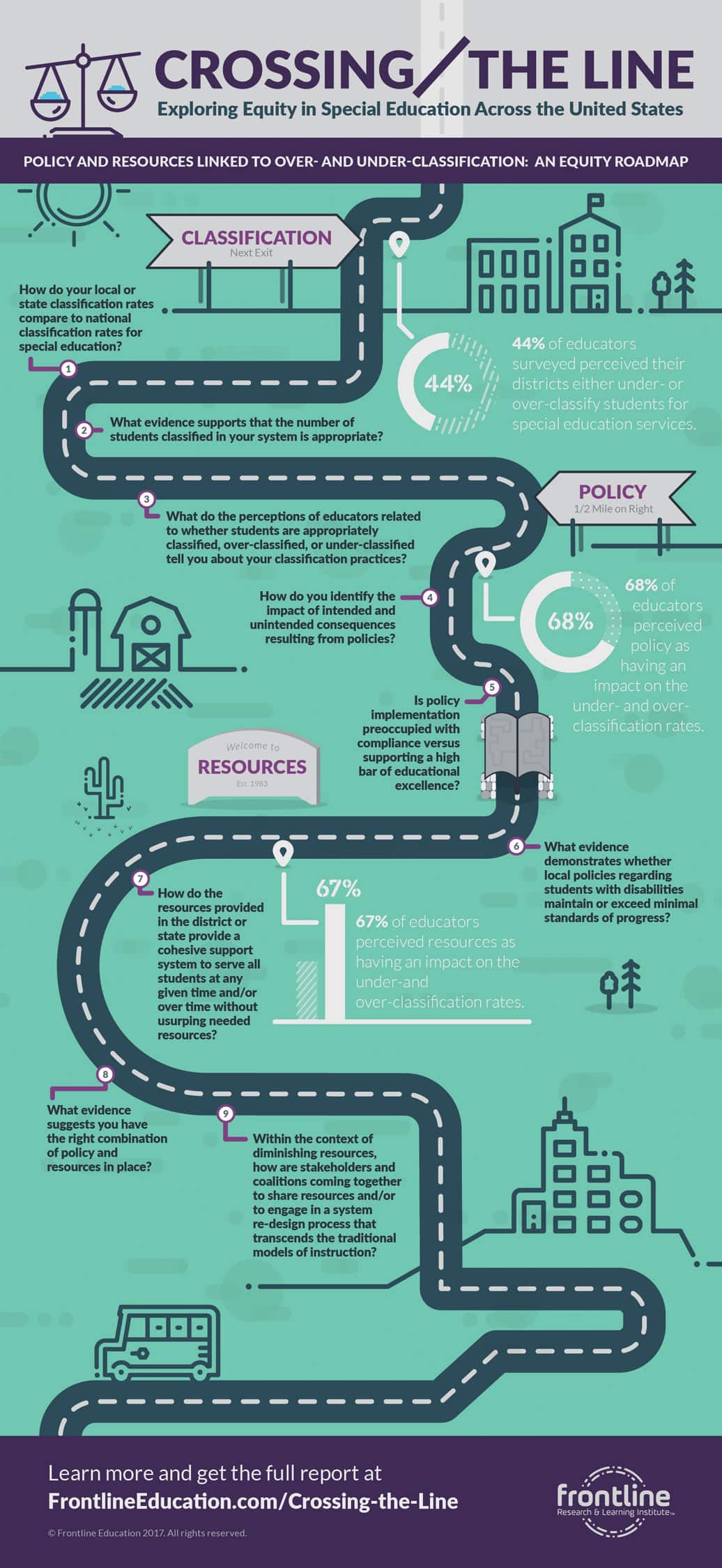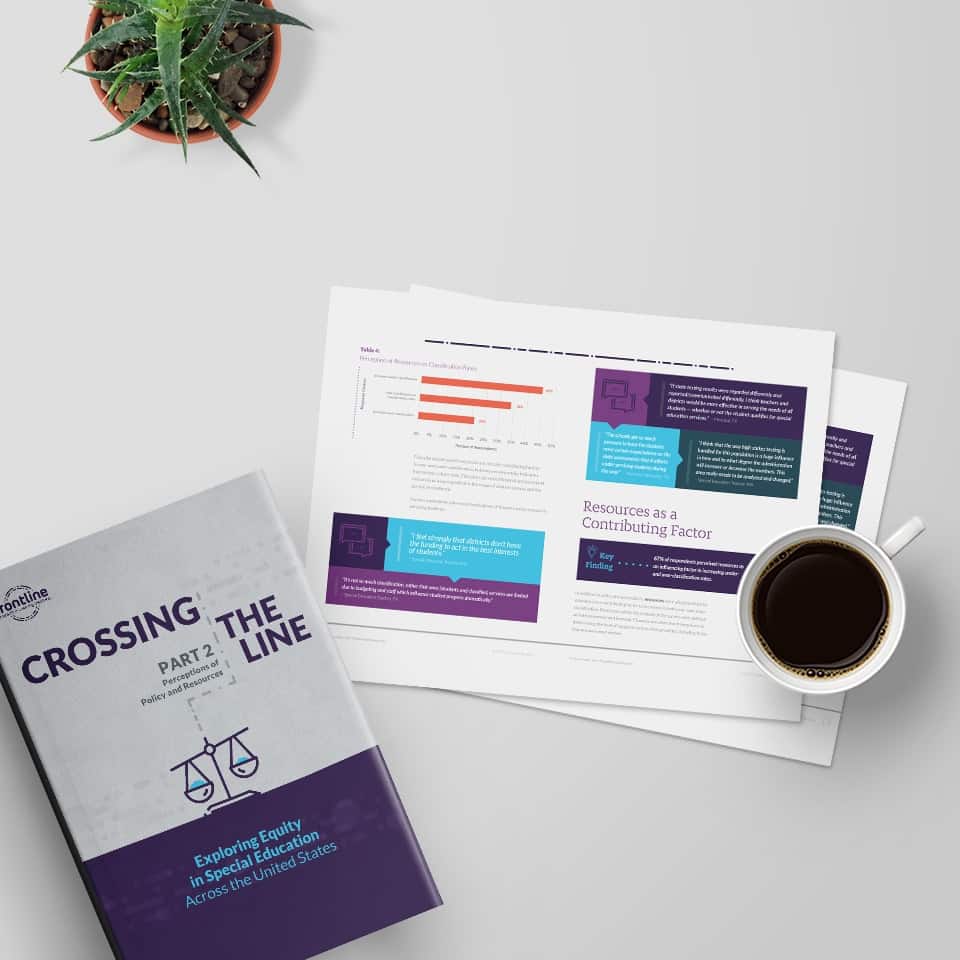Second Report in Frontline Research & Learning Institute series indicates educators believe policy and resources are major sources of misclassification which can have life-long consequences for special education students.
MALVERN, PENNSYLVANIA – December 12, 2017 – The Frontline Research & Learning Institute today announced the release of a second report in a four-part series focused on equity in special education classification rates for American students. Following a report that looked at the variance in classification rates, the new report explores the basis for misclassification.
A majority of educators surveyed believe district policy and resources have significant bearing on under- and over-classification.
The report, titled “Crossing the Line”, is based on a survey of more than 3,600 educators in 19 different educational positions across their 12,000 educational organizations across the United States. The research series aims to provide actionable insights that inform discussion about how states and local districts equitably address the needs of students.
“Talking about how misclassification happens is important at this very moment considering shifting federal policy impacting special education decision-making,” said Dr. Thomas Reap, co-author of the report and Executive Director of Special Education and Interventions at Frontline Education. “While there is some uncertainty about which Department of Education regulations will stand, overall policy favors greater transparency, accountability and increased resources to serve special education students which makes this conversation about classification especially timely for administrators and teachers on the front line of education.”
Examining the rationale for misclassification and fully understanding a wealth of data helps educators consider what equitable practices will deliver meaningful support and services for students.
Accountability and assessment appear to be significant factors influencing policy as a contributing factor to misclassifications. Survey respondents believed administrators face mounting accountability and assessment pressure created by state policy that results in misclassification. Principals (43 percent) and special education teachers (41 percent) perceive policy to have a greater influence on increasing under-classification rates.
A majority of respondents (67 percent) also cited resources – both personnel and financial – as a contributing factor for misclassification and almost 2 to 1 said resources have a greater influence on increasing under-classification than over-classification rates.
“Finances are the primary driver of the level of supports and services provided including personnel,” said Reap. “Personnel, in particular special education teachers, service providers and specialists are in short-supply and high demand and districts are challenged to recruit and hire them, especially in light of decreasing college special education program participants. Without quality teachers, it is difficult to provide students with a continuous, equitable and high caliber education.”
For context, the survey also looked at how special education teachers, principals and administrators across the highest classification states (New York, Massachusetts, Maine and Pennsylvania) as well as lowest classification states (Texas, Idaho, Colorado and Hawaii) think about the impact of policy on classification.
In the highest classification states, principals (73 percent) perceived district policy as a greater influence on over-classification, while in the lowest classification states principals (49 percent) perceived district policy to have the greatest influence on under-classification.
Administrators of special education (41%) and principals (73%) in the highest classification states agreed that policy has a greater influence on over-classification. Conversely, special education teachers in both the highest classification states (46%) and lowest classification states (38%) perceived policy as having a greater influence on under-classification.
In the highest classification states, administrators of special education and principals were almost equally divided on their perception of resources as increasing both under- and over-classification rates. Special education teachers in those same states, however, saw resources as a greater factor in under-classification (55 percent) versus over-classification (19 percent). Educators believe there is an unmet need for special education, which could be a result of lack of district financial resources.
In the lowest classification states, administrators of special education (44 percent), principals (50 percent) and teachers (46 percent) perceived resources to have a greater impact on under-classification versus over-classification. This is likely attributed to the fact that when districts do not have the resources to serve students, they may be less likely to appropriately classify students with special needs.
“The Crossing the Line” report includes an Equity Roadmap to examine policy and resources that influence and contribute to the pursuit and ultimate achievement of special education equity.
“The goal of the Equity Roadmap is to engage states and local districts in assessing and initiating discussions of how special education equity reflects decision-making and practices related to the implementation of policy and allocation of resources,” said Jo Ann Hanrahan, co-author of the report and Frontline Director of Research and Data Analysis. “Over- and under-identifying students for special education students has the potential to imperil equity and can have long-term impact for our children.”
“Crossing the Line” is available for download here. Over the next year, The Frontline Research & Learning Institute plans to release two additional reports.
About the Frontline Research & Learning Institute:
The Frontline Research & Learning Institute is a division of Frontline Education, an integrated insights partner to K-12 organizations nationwide. The Institute is a learning organization dedicated to providing data-driven research, resources, and observations to support and advance the educational community. Driven by the vast amount of records across Frontline’s comprehensive solutions portfolio, the Institute leverages data from more than 12,000 educational organizations and several million users to reach findings and provide benchmarks that inform strategic decision-making for the education community. The Frontline Research & Learning Institute works with Johns Hopkins Center for Research and Reform in Education to ensure all research reports and analyses are rigorously-validated and representative of national data.
Press Resources:
Media Contact
Andrea Fitzpatrick
afitzpatrick@frontlineed.com
484-983-8688

Crossing the Line: An Equity Roadmap

Crossing the Line | Part 2: Perceptions of Policy and Resources